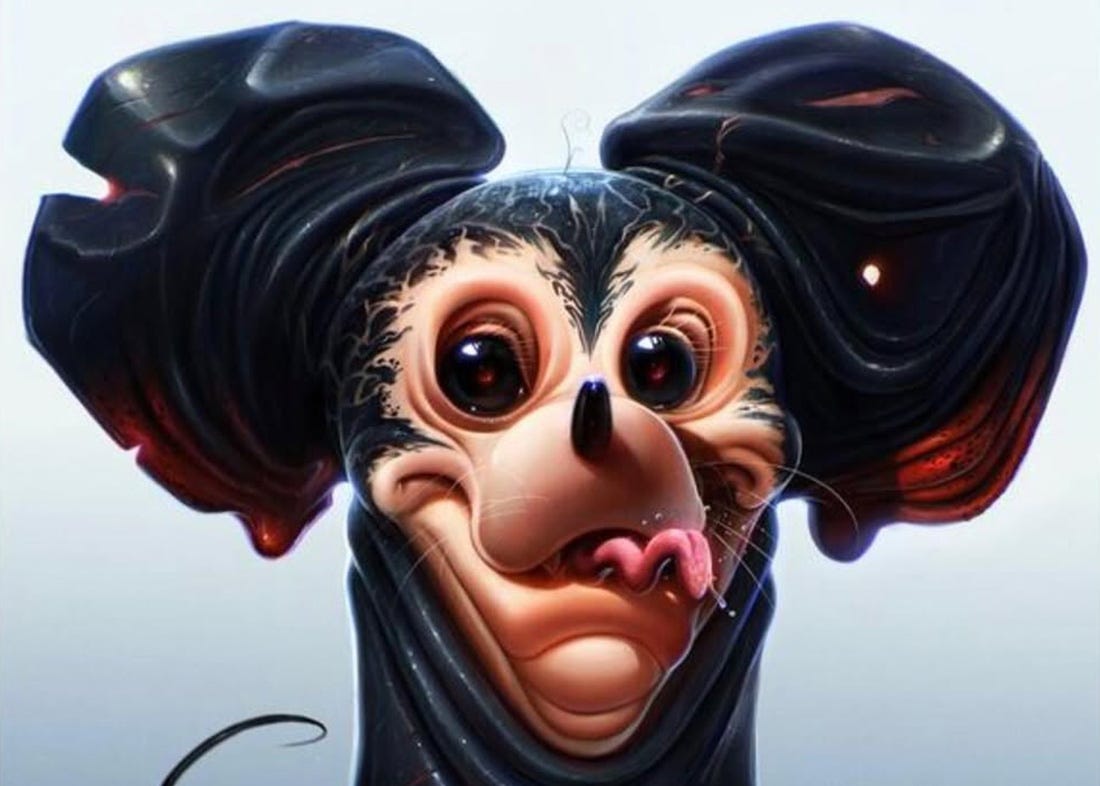Have a Disgusting New Year!
🤢 Why do people indulge in the art of nasty?
The holiday season often brings warmth, joy, and wonder in our lives. But this is not the only way to experience magic. What about the grotesque? Is there no place in our hearts for the ugly and the yucky?

The ambivalent nature of disgust has always puzzled me. Why is Dr. Pimple-Popper a hit series? Why do we enjoy the close-ups in SpongeBob SquarePants? I cannot stand to watch, but I’m glued to it. Why is it so hard to look away?
There’s seemingly no logic in this perversion. Or is there? Perhaps there is beauty on the floors of public bathrooms, just like in Giger’s twisted brain. Maybe I merely don’t know enough.
This is Beyond the Veil, where we explore nerdy topics and collect indie (or at least lesser-known) art that relates to them.
Why do we do this to ourselves?
Our fascination with repulsive characters and themes, particularly within the realms of fantasy and sci-fi, reveals a complex interplay of human psychology, cultural norms, and aesthetic pleasure. I think, this is not just a niche interest but a reflection of our deeper emotional and cognitive processes.
Disgust is often painted as purely negative, but if that’s true, artists wouldn’t explore the themes that created the Alien series. Bavis and Butthead would look like Snow White, and eXistenZ wouldn’t make sense.
Carolyn Korsmeyer argues that engaging with disgusting art or characters can induce curiosity, and enhance cognitive engagement. Viewers can explore complex emotions without real-world consequences.1
Moreover, the concept of escapism plays a significant role. In the safe environment of alternate realities, we can explore darker themes and emotions. And identifying with repulsive characters can even lead to catharsis, as we confront aspects of our own identities that society typically shuns.2
In a way, we find our own thoughts repulsive. Which can intrigue us to dig deeper if we manage not to run away.
The age of nasty?
It wasn’t always like this.
We used to banish birth, decay and other forms of human vulnerability to private spaces. Kant even associates disgust with a lack of artistic value.3 But society seems to be leaning the other way. Social media, TV, art galleries embrace (some) of the uncomfortable rawness of reality and free the taboo.
There’s something about peeling back the layers and staring at what’s beneath, even if it’s repulsive.
Shows like Dr. Pimple Popper have turned curiosity into a shared spectacle, as we watch blemishes transformed, scars revealed, and “imperfections” resolved.
And in a world where so much feels fake, the grotesque stands out as refreshingly authentic. Furthermore, disgusting art can foster community among fans who appreciate niche aesthetics. This shared interest creates a sense of belonging, allowing individuals to connect over their appreciation for the bizarre in ways that challenge traditional notions of beauty and morality.4
So What?
I used to think disgust was something to avoid. But the more I dive into stories and art, the more I realise: it’s not that simple. Disgust doesn’t just repel us; it draws us in. It teases our curiosity. It asks us to stay a little longer and figure out why we’re so uncomfortable.
Art doesn’t need to be pleasant to be meaningful. Negative aesthetics challenge traditional beauty and drive us towards more nuanced thinking. They compel us to examine the darker layers of existence with soft curiosity.
That moment you flinch? That’s art shaking you awake.
Relevant article
The Grey Tide: Why we want an affair with the Dark Side?
“Whatever horror waited beyond the stars was being given a way through.”
Are you here for The List?
Don’t worry, we will send it to you this week. Artists, games, animations, and maybe some random jewels…
Why later? We have been collecting more and more lesser and lesser known art projects. 12 is our new target number for quality picks, and we need a little time to achieve that.
We are a tiny team of artists (3+2×0.5 to be exact), and we do this out of love. So if you agree with the message of this newsletter, let us know by sharing with a friend.
We are keen to support upcoming art projects to revive the playful, creative side of humanity, and I know you have some ideas how. 😉
Until then…
Check out these lists from the curious creators of Omnimorphs.
Time to escape to your world of creativity and build!
Adrián
Scribe of the Omniscient
👁🗨
This newsletter is crafted with 💜 by humans. We use AI for online research and English language accuracy.
Fun quote
“Strange flesh clung to humanoid form, its surface seeming to crawl almost imperceptibly like the liquid that filled this place. They spoke to him, offering him the power to overcome his foe.”
quote from our narrative artbook Omnimorphs: Beyond the veil









